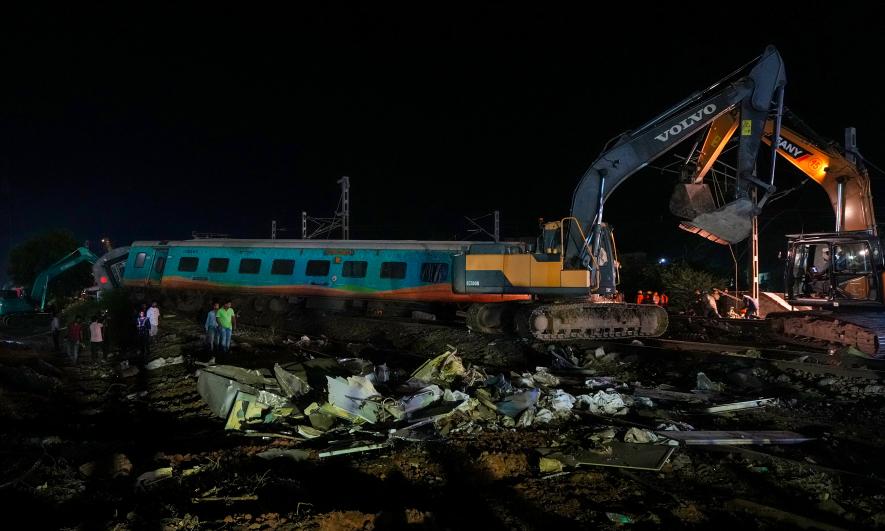Odisha Train Crash: Rail Ministry Claims to Have Identified' Root Cause', Reports Suggest Negligence, Lapses

A rescue and search operation being conducted after the accident involving three trains that claimed at least 261 people and left over 900 injured, in Balasore district, Odisha, Saturday, June 3, 2023. Image Courtesy:PTI Photo/Swapan Mahapatra
New Delhi: The June 2 horrific train crash in Odisha's Balasore that left over 280 dead and 1,175 injured exposes a manufactured disaster caused by utter negligence, serious system lapses and inefficiency. Despite several warnings, there appears to be criminal neglect of the signalling system.
Interlocking alteration has again been suspected as the probable reason behind the Balasore mishap. The crash involved the Shalimar-Chennai Central Coromandel Express, the Bengaluru-Howrah Superfast Express (both of them together carrying around 2,000 passengers) and a goods train. It occurred around 7 pm near Balasore's Bahanaga Bazar station — about 170 km north of Bhubaneswar (Odisha) and 250 km south of Kolkata (West Bengal).
Citing a preliminary investigation report by the State Emergency Operation Centre and Special Relief Commissioner, which is in possession of NewsClick, the Railway Board on June 4 said there was some issue with the signalling.
"According to the preliminary findings, there has been some issue with the signalling. We are still waiting for the detailed report from the Commissioner of Railway Safety," Jaya Varma Sinha, member of Operation and Business Development, Railway Board, told reporters while explaining the sequence of events that led to one of the deadliest train accidents in the Indian Railways' history.
Read Alao: Balasore Train Tragedy Exposes Ignored Warnings and Lakhs of Vacant Positions in Indian Railways
Instead of moving ahead on the main track, the Coromandel Express (12841) — reveals the report — entered a loop line after a green signal given to it to enter the mainline was taken off. As a result, it collided with a stationary goods train parked there.
In the meantime, the Bengaluru-Howrah Superfast Express (train number 12864) — it says — passed through the down main line, and two coaches derailed and capsised. While Coromandel Express was at a speed of 128 mph, the Bengaluru-Howrah Superfast Express was running at 116 mph.
The loop lines accommodate more trains to ease operations. It is generally 750 metres in length to accommodate full-length goods train with multiple engines.
"All the stations have two lines and two loop lines. We operate on a point determining whether the train will go straight or on a loop. Signals are interlocked in a manner that it helps in knowing whether the line is occupied. The signal is green when the point is not occupied. The interlocking is done in a manner that helps to know if the movement is clear. The interlocking was electronic in this station. More can be known if there is electronic interlocking. Some stations are still using levers," Sandeep Mathur, Railway Board's principal executive director (signal modernisation), told the media.
Meanwhile, Railway Minister Ashwini Vaishnaw has claimed that the "root cause" of the tragedy has been identified and will be revealed soon. He said the deadly accident occurred due to a "change in the electronic interlocking".
As per the extant rules and procedures, the electrical signal maintainer (ESM) shall serve a disconnection memo to the station master — who acknowledges it and then give permission to attend to any failures.
How can anyone meddle with the interlocking gears without opening the Relay Room when there are clear guidelines from the Railway Board for opening it to attend failures? How come an ESM get access to alter the interlocking without opening the Relay Rooms?
CRIMINAL NEGLECT OF THE SIGNALLING SYSTEM?
On February 9, the Principal Chief Operating Manager of South Western Railway raised concern over the signal failure of Sampark Kranti Express (Train No. 12649) on February 8 at Hosadurga Road — a double line station between Shivani and Ramagiri in Birur-Chikkajajur section of Mysore Division.
The train was headed toward a head-on collision with a goods train, approaching the Hosadurga station in a downward direction; however, this was averted because of the loco pilot's alertness, who stopped it before entering the wrong line (down the line).
Read Also: Railway Brass Had Flagged Unfilled Vacancies as Key Reason for Rise in Mishaps in 2022-23
"The incident indicates that there are serious flaws in the system, where the route of dispatch gets altered after a train starts on signals with correct appearances of the route in the SMs (station masters) panel. This contravenes the essence and basic principles of inter-locking," he said in his detailed report addressed to the Operating Department of the Hubballi-based Headquarters' Office.
The signalling cables at many stations across the country, the report says, are first brought to a junction box in the yard and then to the Relay Rooms. "It makes it vulnerable for meddling and interfering with interlocking," the report notes, cautioning to take the February 8 incident "very seriously".
"Immediate corrective actions are required to be taken to rectify the system faults," says the report, adding, "It is high time that some serious work is done on this front to ensure that precious lives and safety of people are not put at risk."
SAFETY PROCEDURES IGNORED
The Parliamentary Standing Committee on Transport, Tourism and Culture, in its 323rd report, had criticised the Railway Board for the "disregard" towards the recommendations of the Commission of Railway Safety (CRS).
It is to direct, advise and caution the Railway Board through its supervisory, investigative and advisory functions and thereby assist in ensuring that all prescribed measures are taken, and standards are adhered to and have been implemented concerning the strength of the rail, construction and safety in train operations.
The CRS is under the administrative control of the Ministry of Civil Aviation. The Committee had recommended that the Commission be made an independent, autonomous body just like many other regulatory institutions of the country to improve efficiency and freedom of action.
Pointing out the Railway Board's "gross disregard" for the CRS, the Committee report states that "only 8-10% of accidents are investigated by the CRS, while the rest are probed by the Railways, and the reports in such cases are not even referred to CRS for comments".
CAG REPORT RAISES SERIOUS CONCERNS
The Comptroller and Auditor General (CAG), India's top auditing body, in a 2022 report on "Derailments in Indian Railways", held Indian Railways' engineering department responsible for most derailments.
From April 2017 to March 2021, the report attributed 422 derailments to the department.
The report pointed towards poor track maintenance, overspeeding and mechanical failure as significant reasons for derailments.
It had also flagged inadequate staffing in safety operations, the declining trend in funding track renewal, not utilising a dedicated railway fund on priority, failure to submit or accept inquiry reports after accidents and severe shortfalls in inspections as serious concerns.
"There were shortfalls ranging from 30-100% in inspections by Track Recording Cars required to assess geometrical and structural conditions of railway tracks," said the report, which is with NewsClick.
It also referred to failures in the Track Management System (TMS), widely discussed after the Odisha train crash.
"The TMS is a web-based application for online monitoring of track maintenance activities. The in-built monitoring mechanism of the TMS portal was, however, not found to be operational," it pointed out.
The idling of track machines, said the report, was noticed on account of no scope of work (3%), non-availability of staff (5%), operational problems (19%), blocks not planned by divisions (30%), and blocks not given by the operating department (32%).
Analysing 1,129 'Inquiry Reports' of derailment accidents in 16 Zonal Railways, the audit found "23 factors responsible for derailments in selected 1,129 cases/accidents that occurred in 16 zonal railways".
Out of 23 reasons, the major factor responsible for derailments was "maintenance of track" (171 cases), followed by "deviation of track parameters beyond permissible limits" (156 cases) and "bad driving/overspeeding" (154 cases).
Long working hours of loco pilots due to an acute shortage of workforce was suspected to be the main reason for the increasing number of accidents, especially signal danger passing (SPAD) cases, the report found.
The number of derailments attributable to the 'mechanical department' was 182. Defects in "wheel diameter variation and defects in coaches/wagons" were the major contributor (37%) to the factors responsible for derailments.
The number of accidents attributable to the "operating department" was 275. "Incorrect setting of points and other mistakes in shunting operations" accounted for 84%.
In 63% of cases, the CAG pointed out, the "inquiry reports" were not submitted to the accepting authority within the prescribed schedule. In 49% of cases, there was a delay in accepting the reports by accepting authorities.
The report further said fire extinguishers were not provided in 27,763 coaches (62%), violating extant norms.
The report also stated that the total allocation of funds for track renovation was dwindling, and even the allocated funds were not fully utilised. This is worrying as the report also states that 26% of the total derailments during 2017-21 were caused because of poor maintenance of tracks.
The audit report also pointed out that the allocation of funds for track maintenance and upgradation works decreased from Rs 9,607.65 crore in 2018-19 to Rs 7,417 crore in 2019-20. "The funds allocated to track maintenance were also not fully utilised," it said.
As against 35 accidents reported last year (2021-22), said the report, 48 cases of "consequential rail accidents" (mishaps with serious consequences in terms of loss of life, property etc.) were reported in 2022-23. There were 165 "non-consequential train accidents" as well, including 35 cases of SPAD, it said.
The accidents reported damage/loss of assets worth Rs 32.96 crore.
The Rashtriya Rail Suraksha Kosh (RRSK) was created in 2017-18 with an annual outlay of Rs 20,000 crore to ensure complete safety. Its corpus had to grow to Rs 1 lakh crore over five years. But "low deployment of funds from internal resources by the Railways" (Rs 15,775 crore) defeated the primary objective of its creation, the report found.
The report also revealed zero testing of rails and welds in East Coast Railway in 2017-21.
SHORTAGE OF HUMAN RESOURCE
Various departments of the Indian Railways have lakhs of vacant seats, reveals a reply furnished under the Right to Information (RTI). Of 14,75,623 Group C posts, over 3.11 lakh are vacant. Of 18,881 sanctioned gazetted cadre posts, 3,018 are lying vacant, it said.
Most of the 39 railway zones and production units, it said, lack the required human resources.
The RTI response said appointments of top railway officials, whose seats have been lying vacant for months, have been delayed by the Appointments Committee of the Cabinet Secretariat.
The Railway Board, the reply said, has recently taken up the issue of loco pilots who are forced to work beyond their prescribed working hours — resulting in a threat to the safety of train operations.
Read Also: Indian Railways has Over 77,000 Vacancies in Signal, Traffic Departments
According to the rules, their duty hours cannot exceed 12 hours under any circumstances. But due to a workforce shortage, many zonal railways asked loco pilots to stay on duty beyond the prescribed duty hours.
For example, in South East Central Railway, the duty hours of loco pilots on duty for more than 12 hours in the first half of March, April and May this year were 35.99%, 34.53% and 33.26%, respectively, revealed the RTI response.
HOLLOW' KAVACH'
The Train Collision Avoidance System (TCAS) developed by the Research Designs and Standards Organization (RDSO) in 2011-12 was named 'Kavach'. Demonstrating TCAS, the railway minister, in March 2022, explained in detail its functioning.
But contrary to the claims that all trains will be equipped with anti-derailment and anti-collision devices to ensure the safety of railway passengers, none of the trains that crashed in Odisha neither had 'Kavach' nor was it covered by the National Automatic Train Protection System or armour.
NO ‘CHINTAN’ ON SAFETY IN ‘CHINTAN SHIVIR’
A 'Chintan Shivir' or brainstorming session chaired by the railway minister was organised hours before the tragic incident on June 2. If the officials who attended the event are to be believed, presentations from various sectors on railway safety were sidelined.
"While discussions were largely held on Vande Bharat trains and raising revenue, only one zone was allowed to make a presentation on security," media reports have quoted several officials.
"In recent months, there have been alarming incidents of derailments of goods trains where loco pilots were killed, and wagons were completely destroyed. But no discussion was held to prevent such accidents," said a railway official who was part of the session.
But the allegation was outrightly rejected by the Railway Board member, Jaya Varma Sinha, who termed it "baseless".
Get the latest reports & analysis with people's perspective on Protests, movements & deep analytical videos, discussions of the current affairs in your Telegram app. Subscribe to NewsClick's Telegram channel & get Real-Time updates on stories, as they get published on our website.























